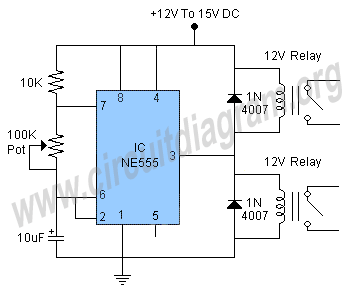
Relay Timer with ATmega8 AVR MCU

A simple timer that can be used to turn a load on or off after a user-specified time. The prototype was developed using the xBoard MINI, a low-cost and easy-to-use ATmega8 development board. The program was burned to the MCU's flash memory using eXtreme Burner - AVR Software and Hardware. The Simple Device Timer project is designed using the ATmega8 AVR MCU. The timer is useful for keeping a device "ON" for a specific period. Once the set time elapses, the timer automatically turns the load off. The timer utilizes a standard 16x2 LCD module for the user interface. The user can set the time using a 3-button keypad. After setting the time, the timer is started, and while the countdown is in progress, the remaining time is displayed on the screen. The program utilizes an LCD driver library, with more details available on the website. The avr-gcc compiler and AVR Studio are used for compilation.
The Simple Device Timer circuit employs an ATmega8 microcontroller, which serves as the core processing unit. The ATmega8 is a versatile 8-bit AVR microcontroller featuring 8 KB of flash memory, 1 KB of SRAM, and 512 bytes of EEPROM, making it suitable for various applications, including timing and control tasks. The xBoard MINI development board provides a convenient platform for prototyping, integrating essential components like power supply, crystal oscillator, and programming interface.
The timer's user interface is facilitated by a 16x2 LCD module, which displays the countdown timer and allows users to interact through a 3-button keypad. The keypad typically consists of three buttons: one for increasing the time, one for decreasing it, and one for starting the timer. The microcontroller reads the button presses through its digital input pins, enabling user input to adjust the timing parameters.
The countdown functionality is implemented through an interrupt-driven approach, where the microcontroller utilizes its internal timers to keep track of elapsed time. Once the user sets the desired time and starts the timer, the program enters a loop that continuously updates the LCD display with the remaining time. When the countdown reaches zero, the microcontroller activates a relay or transistor to turn off the connected load, ensuring that the device operates only for the specified duration.
The use of the avr-gcc compiler and AVR Studio for development allows for efficient programming and debugging of the microcontroller, ensuring reliable operation of the timer. The inclusion of an LCD driver library simplifies the process of controlling the LCD module, enabling smooth updates to the display without extensive coding overhead. Overall, this Simple Device Timer project exemplifies an effective application of microcontroller technology in creating user-friendly timing solutions.A simple timer that can be used to turn on/off a load after user specified time. The prototype was developed using xBoard MINI, a low cost easy to use ATmega8 development board. The program was burned to the MCU`s flash memory using eXtreme Burner - AVR Software and Hardware. The Simple Device Timer project designed using ATmega8 AVR MVU. The Timer is usefully for keeping a device "ON" for a specific period of time. After the set time elapse the timer automatically turns the load off. The Timer uses a standard 16x2 lcd module for user interface UI. User can set the time using a 3 button keypad. After that Timer is started. While count down is in progress, the time left is displayed on screen. The program use our LCD driver library more details of which can be found in Web site. Use avr-gcc + AVR Studio to compile. 🔗 External reference
The Simple Device Timer circuit employs an ATmega8 microcontroller, which serves as the core processing unit. The ATmega8 is a versatile 8-bit AVR microcontroller featuring 8 KB of flash memory, 1 KB of SRAM, and 512 bytes of EEPROM, making it suitable for various applications, including timing and control tasks. The xBoard MINI development board provides a convenient platform for prototyping, integrating essential components like power supply, crystal oscillator, and programming interface.
The timer's user interface is facilitated by a 16x2 LCD module, which displays the countdown timer and allows users to interact through a 3-button keypad. The keypad typically consists of three buttons: one for increasing the time, one for decreasing it, and one for starting the timer. The microcontroller reads the button presses through its digital input pins, enabling user input to adjust the timing parameters.
The countdown functionality is implemented through an interrupt-driven approach, where the microcontroller utilizes its internal timers to keep track of elapsed time. Once the user sets the desired time and starts the timer, the program enters a loop that continuously updates the LCD display with the remaining time. When the countdown reaches zero, the microcontroller activates a relay or transistor to turn off the connected load, ensuring that the device operates only for the specified duration.
The use of the avr-gcc compiler and AVR Studio for development allows for efficient programming and debugging of the microcontroller, ensuring reliable operation of the timer. The inclusion of an LCD driver library simplifies the process of controlling the LCD module, enabling smooth updates to the display without extensive coding overhead. Overall, this Simple Device Timer project exemplifies an effective application of microcontroller technology in creating user-friendly timing solutions.A simple timer that can be used to turn on/off a load after user specified time. The prototype was developed using xBoard MINI, a low cost easy to use ATmega8 development board. The program was burned to the MCU`s flash memory using eXtreme Burner - AVR Software and Hardware. The Simple Device Timer project designed using ATmega8 AVR MVU. The Timer is usefully for keeping a device "ON" for a specific period of time. After the set time elapse the timer automatically turns the load off. The Timer uses a standard 16x2 lcd module for user interface UI. User can set the time using a 3 button keypad. After that Timer is started. While count down is in progress, the time left is displayed on screen. The program use our LCD driver library more details of which can be found in Web site. Use avr-gcc + AVR Studio to compile. 🔗 External reference





